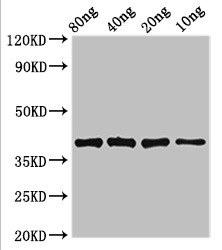lexA Antibody (PACO50402)
- SKU:
- PACO50402
- Product type:
- Antibody
- Reactivity:
- Escherichia coli
- Host Species:
- Rabbit
- Isotype:
- IgG
- Application:
- ELISA
- Application:
- WB
- Antibody type:
- Polyclonal
- Conjugation:
- Unconjugated
Frequently bought together:
Description
| Antibody Name: | lexA Antibody (PACO50402) |
| Antibody SKU: | PACO50402 |
| Size: | 50ug |
| Host Species: | Rabbit |
| Tested Applications: | ELISA, WB |
| Recommended Dilutions: | ELISA:1:2000-1:10000, WB:1:500-1:5000 |
| Species Reactivity: | Escherichia coli |
| Immunogen: | Recombinant Escherichia coli LexA repressor protein (1-202AA) |
| Form: | Liquid |
| Storage Buffer: | Preservative: 0.03% Proclin 300 Constituents: 50% Glycerol, 0.01M PBS, pH 7.4 |
| Purification Method: | >95%, Protein G purified |
| Clonality: | Polyclonal |
| Isotype: | IgG |
| Conjugate: | Non-conjugated |
 | Western Blot. Positive WB detected in Recombinant protein. All lanes: lexA antibody at 3.4µg/ml. Secondary. Goat polyclonal to rabbit IgG at 1/50000 dilution. predicted band size: 39 kDa. observed band size: 39 kDa.. |
| Background: | Represses a number of genes involved in the response to DNA damage (SOS response), including recA and lexA. Binds to the 16 bp palindromic sequence 5'-CTGTATATATATACAG-3'. In the presence of single-stranded DNA, RecA interacts with LexA causing an autocatalytic cleavage which disrupts the DNA-binding part of LexA, leading to derepression of the SOS regulon and eventually DNA repair. Implicated in hydroxy radical-mediated cell death induced by hydroxyurea treatment.The SOS response controls an apoptotic-like death (ALD) induced (in the absence of the mazE-mazF toxin-antitoxin module) in response to DNA damaging agents that is mediated by RecA and LexA. |
| Synonyms: | LexA repressor (EC 3.4.21.88), lexA, exrA spr tsl umuA |
| UniProt Protein Function: | Represses a number of genes involved in the response to DNA damage (SOS response), including recA and lexA. Binds to the 16 bp palindromic sequence 5'-CTGTATATATATACAG-3'. In the presence of single-stranded DNA, RecA interacts with LexA causing an autocatalytic cleavage which disrupts the DNA-binding part of LexA, leading to derepression of the SOS regulon and eventually DNA repair. Implicated in hydroxy radical-mediated cell death induced by hydroxyurea treatment (PubMed:20005847).The SOS response controls an apoptotic-like death (ALD) induced (in the absence of the mazE-mazF toxin-antitoxin module) in response to DNA damaging agents that is mediated by RecA and LexA (PubMed:22412352). |
| UniProt Protein Details: | |
| NCBI Summary: | LexA autocleavage, stimulated by RecA, of the first 84 aa of LexA removes the DNA binding region and is required to activate the SOS response. [More information is available at EcoGene: EG10533]. LexA is a protein that belongs to the LexA family . [More information is available at EcoCyc: EG10533]. |
| UniProt Code: | P0A7C2 |
| NCBI GenInfo Identifier: | 16131869 |
| NCBI Gene ID: | 948544 |
| NCBI Accession: | NP_418467.1 |
| UniProt Secondary Accession: | P0A7C2,P03033, Q2M6R1 |
| UniProt Related Accession: | P0A7C2 |
| Molecular Weight: | 38.4 kDa |
| NCBI Full Name: | transcriptional repressor of SOS regulon |
| NCBI Synonym Full Names: | |
| NCBI Official Symbol: | lexA |
| NCBI Official Synonym Symbols: | ECK4035; exrA; JW4003; spr; tsl; umuA |
| NCBI Protein Information: | transcriptional repressor of SOS regulon |
| UniProt Protein Name: | LexA repressor |
| UniProt Synonym Protein Names: | |
| Protein Family: | LexA repressor |
| UniProt Gene Name: | lexA |
| UniProt Entry Name: | LEXA_ECOLI |




